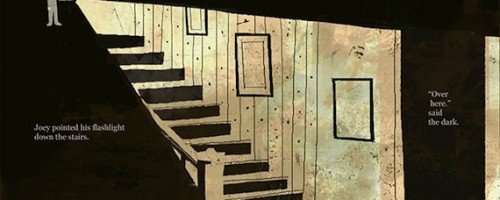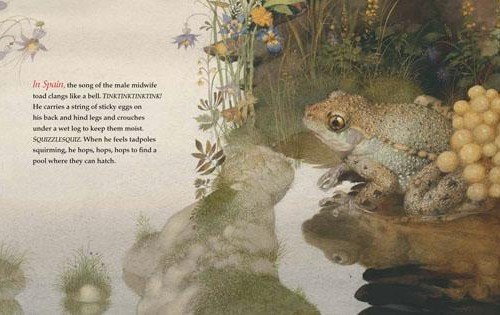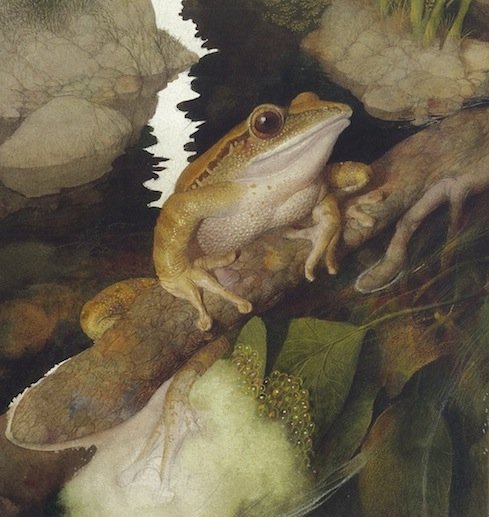Geez, it seems like I just finished writing about Jon Klassen’s This is Not My Hat and another book has appeared on the shelves. The guy is a machine, and I mean this in the nicest way possible. Just because he is prolific doesn’t mean his work is less than magnificent each time out. On the contrary, Klassen continues to show us unique facets of his creativity, which is boundless, if not a little warped. With The Dark, Klassen teams with fellow quirkmeister of children’s literature, Lemony Snicket for a singular unfortunate event, rather than a series. The monochromatic story is set in an old house, with a claw-foot tub and a lot of creaky wooden doors. Young pajama-wearing Laszlo is afraid of the dark, which is an actual thing in residence alongside Laszlo and his family. The dark hides in closets, behind shower curtains, or ‘pressed up against some old, damp boxes’, but mostly spends its time in the basement.

Pig in a Pond
Slowly I am making my way through Poly Bernatene’s picture books. The Argentinian illustrator is astoundingly good, and very prolific. His latest book, Ribbit! is, like the others, a feat of illustration. Unlike the others, there is no blue, as in the colour blue. There are wonderful greens and pinks, but for anyone who has seen When Night Didn’t Come, The Tickle Tree, or The Santa Trap, they will understand, Bernatene immerses his illustrations in deep sapphires and lustrous periwinkles. Nevertheless, what Ribbit! lacks in blue, it more than makes up for in the number and quality of frogs, and a friendly, if slightly misunderstood pig.

Hares & Bunnies & Rabbits oh my!
Easter means many things to many people. It is a Christian celebration, a pagan rite, an excuse to sport a frilly bonnet, and for me, a time to dismember a chocolate bunny, starting with the head. Yes, it’s all about the rabbits, regardless of what anyone tells you.
Lovely picture books about rabbits abound, and I could easily pen a few words at any time of the year. However, Easter is when my brain is at its most bunny-filled and hare-focused, and while these internal images are of a similar breed (chocolate), I am willing to direct my thoughts to rabbits of the illustrated variety for the purposes of giving further exposure to a few bunny-centric picture books.

Frog Song
Spring is a fraught subject in this part of the world. In celebration of the first day of spring, the sky unfurled a massive, white party favour, dropping 30cm of snow over an already thickly blanketed landscape. It was an extravagant display of spring’s absence, in other words, and it will be another month before the ground clears and the grass begins to blush a tentative green. What to do in weather like this? Pour a cup of coffee and read about frogs.
Following in the steps of their previous collaboration-Life in The Boreal Forest, Brenda Guiberson and Gennady Spirin have created the magnificent Frog Song, a paean to the beauty of the natural world, our precarious ecosystem, and spring’s noisiest amphibian.
In onomatopoeic prose (“mwa”, “fwish”, “swee swee”, etc.,), Brenda Guiberson introduces the reader to an international cast of frogs, from the scarlet-sided pobblebonk of northeastern Australia to the European midwife toad, whose eggs are carried by the male on his exterior. In Spirin’s hands, the eggs are a treasure of shimmering amber pearls heaped on the back end of the frog (who appears to be quite proud of his hoard.) I was pleased to see the Canadian wood frog, a pillar of endurance and adaptability in its ability to transform itself into a frogsicle in winter, included in the book. Once thawed, the wood frogs’ eggs are deposited along stream beds before the ice has completely melted. In  my city, a bog located in a ravine I frequent bubbles to life in the spring, and the surface activity is accompanied by a soundtrack unlike anything I’ve ever heard, as if someone were pushing a stroller across gravel. Initially, I couldn’t place the source, but later discovered the strange sound was the mating song of the boreal chorus frog, a relative of the wood frog. No stereotypical ‘ribbit’ from this crowd, just rhythmic ‘craaacks’. It is something I look forward to every spring, although judging by the amount of snow outside, it will be awhile before the woods are filled with love-sick frog songs.
my city, a bog located in a ravine I frequent bubbles to life in the spring, and the surface activity is accompanied by a soundtrack unlike anything I’ve ever heard, as if someone were pushing a stroller across gravel. Initially, I couldn’t place the source, but later discovered the strange sound was the mating song of the boreal chorus frog, a relative of the wood frog. No stereotypical ‘ribbit’ from this crowd, just rhythmic ‘craaacks’. It is something I look forward to every spring, although judging by the amount of snow outside, it will be awhile before the woods are filled with love-sick frog songs.
The illustration of the Costa Rican strawberry poison dart frog on the cover of Frog Song is so extraordinarily moist and life-like, it looks like a photograph, which is misleading. Frog Song is a work of imagination. It is a work of art. The cropped image is part of a much larger, two-page illustration. Not shown (on the cover) is the gently scalloped leaf the frog sits upon, and the brocade background of periwinkle blues and tropical greens woven together with such sensitivity, the effect is breathtaking. The art is realistic in the sense that the amphibians are scientifically identifiable (if not slightly more expressive), but the visual depiction of frogs and frog life within their natural habitat is as exquisite as a Renaissance painting. Swamp life has never been so richly detailed, with gorgeous insects, plants, and daubs of brilliant colour illuminating the background. Even more mind boggling is Spirin’s prolificity (he illustrates two or three books a year) given that each illustration in tempera, pencil, and watercolour has the sort of time-consuming, layered detail one would expect of a much older painter. Centuries older.
As in Life in the Boreal Forest, Guiberson includes a very useful synopsis of the text and some additional facts and websites at the back of the book, along with a plea for ecological stewardship. Frogs all over the world are in trouble, but there is nothing heavy-handed in the message. Frog Song is a celebration; a stunningly beautiful overview of international frog life from one of the greatest illustrators of our time. This frogopedia is not to be missed.
If you do decide to purchase or borrow Frog Song, and I insist that you do, have a look under the front cover. There is a frog not depicted anywhere else in the book; one entirely of Gennady Spirin’s imagination. He appears to be some sort of frog prince, with a lily for a crown and a small gathering of adoring froggy subjects. As any good bibliophile 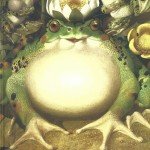 knows, especially one who collects children’s picture books, the boards beneath the cover often hold surprises, and even if they don’t, it’s all part of the experience.
knows, especially one who collects children’s picture books, the boards beneath the cover often hold surprises, and even if they don’t, it’s all part of the experience.
Gennady Spirin was born in the small town of Orekhove-Zuyevo, near Moscow, on Christmas Day, 1948. He graduated from Surikov School of Fine Art at the Academy of Arts in Moscow and Moscow Stroganov Institute of Art. Mr Spirin has received five gold medals from the Society of Illustrators, and has been chosen four times for the New York Times Best Illustrated Books list. He lives in Princeton, New Jersey.
Brenda Guiberson is the author of many books, including Life in the Boreal Forest, Ice Bears, and Cactus Hotel. She lives near Seattle, Washington.
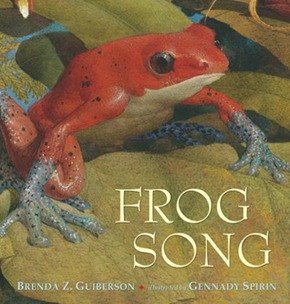 Frog Song by Brenda Z. Guiberson, with illustrations by Gennady Spirin. Published by Henry Holt and Company, 2013
Frog Song by Brenda Z. Guiberson, with illustrations by Gennady Spirin. Published by Henry Holt and Company, 2013
Other reviews: Life in the Boreal Forest by Guiberson & Spirin, Martha by Gennady Spirin
Teacher’s Guide and a few more froggy pictures here
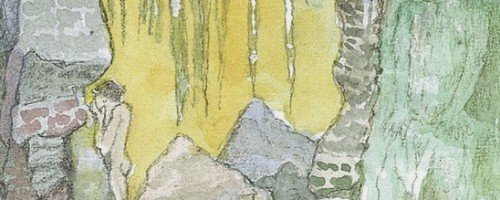
My Brother’s Book
A sad riddle is best for me…
I will confess the first time I read My Brother’s Book, I was confused. Also the second, third, and fourth time. I am still confused, but enthralled. As with all Sendak creations, the mystery beckons. The writing is obtuse, referencing Sendak’s own life, Shakespeare’s The Winter’s Tale, and other works of literature (even Chicken Soup with Rice, Sendak’s 1962 publication.) The art is beautiful, in a watery, unformed way, like a dream, or a painting from William Blake’s Songs of Innocence and Experience. Melancholia permeates his last completed book, and yet, there is a kind (and kind of) resolution to the story. My Brother’s Book is a paean to love, loss, and literature. It is a conundrum. It is a treasure.
On a bleak midwinter’s night, a comet rends the earth in two, catapulting Jack to the continent of ice, and Guy to Bohemia, to the lair of a great white bear. Jack and Guy are brothers, perhaps the homeless brothers from We Are All in the Dumps With Jack and Guy, Sendak’s 1993 picture book. Most certainly, they are Maurice and his older brother Jack, and very likely Maurice and his partner of 50 years, Eugene Glynn. Whatever the true nature of Jack and Guy, they are wretched without one another, and Guy in particular longs to be reunited with the brother he ‘loves more than his own self.’ Trouble is, Jack is encased in ice, ‘his poor nose froze’, and Guy is facing down a bear.
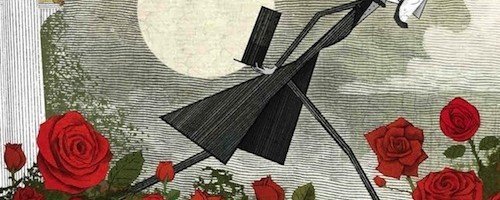
Abe Lincoln’s Dream
OK, I’ll admit it. I’m in the tank for Abraham Lincoln. I love the guy. I really do. I’ve read stacks of books and visited the Lincoln Memorial in Washington, DC twice. I’ve made a pilgrimage to Gettysburg (where I stole a rock), and watched Ken Burns’ The Civil War more times than I care to admit. I’ve not yet seen Steven Spielberg’s Lincoln, or Abraham Lincoln Vampire Hunter, but when I do, I’m sure they’ll be welcome additions to my reference library of Lincolnalia.
I am also in the tank for Lane Smith, the brilliant illustrator of The Very Persistent Gappers of Frip, The Stinky Cheese Man, Spooky ABC, It’s a Book, and Grandpa Green, among many other contemporary classics of children’s literature.
 It goes without saying, that a book about Abraham Lincoln by Lane Smith is a slam-dunk, and yet Abe Lincoln’s Dream is not really about Lincoln the man, but the fruits he laid seed to more than 100 years ago in the United States. My sister picked up this book for me on a recent trip to Arizona. She was peripherally aware of my fondness for Lincoln, and not at all familiar with my illustrative infatuation with Smith. Hats off to her. Stove-pipe hat off to her, I mean. It’s not easy to please my persnickety tastes, but Abe Lincoln’s Dream satiates in every way, from the inventive layouts and old-timey typefaces (thanks to Molly Leach, Smith’s long-time collaborator and partner), to the conception of Lincoln himself, a worry of a man built of vertical lines and furrowed brow. Smith’s books are increasingly atypical, at least in the illustrative sense, but the virtuosity and visual playfulness abide. His illustrations always amuse, always elevate, and Abe Lincoln’s Dream is nothing less than a book about elevation; of a people, there is no doubt, but also of the reader, and a couple of characters who travel the winding paths of history all the way to the moon and back.
It goes without saying, that a book about Abraham Lincoln by Lane Smith is a slam-dunk, and yet Abe Lincoln’s Dream is not really about Lincoln the man, but the fruits he laid seed to more than 100 years ago in the United States. My sister picked up this book for me on a recent trip to Arizona. She was peripherally aware of my fondness for Lincoln, and not at all familiar with my illustrative infatuation with Smith. Hats off to her. Stove-pipe hat off to her, I mean. It’s not easy to please my persnickety tastes, but Abe Lincoln’s Dream satiates in every way, from the inventive layouts and old-timey typefaces (thanks to Molly Leach, Smith’s long-time collaborator and partner), to the conception of Lincoln himself, a worry of a man built of vertical lines and furrowed brow. Smith’s books are increasingly atypical, at least in the illustrative sense, but the virtuosity and visual playfulness abide. His illustrations always amuse, always elevate, and Abe Lincoln’s Dream is nothing less than a book about elevation; of a people, there is no doubt, but also of the reader, and a couple of characters who travel the winding paths of history all the way to the moon and back.

Extinct Boids
“Spring is sprung, the grass is riz. I wonder where the boidies is…”
It started out simply. Ceri Levy, a film-maker, inspired by the subjects of his most recent documentary, The Bird Effect, embarked on an exhibition of extinct and endangered birds, soliciting work from a number of artists, writers and musicians, including one Ralph Steadman. Asked to produce a single extinct bird illustration of his choosing, Steadman, a life-long balker of rules, created more than 100 avian masterpieces; birds of every species, including the newly ‘discovered’ Lousy Grudgian, the Humpbacked Blue Mult, and the Gob Swallow. A special room was dedicated to his illustrations for the duration of the Ghosts of Gone Birds exhibit in 2011, and in 2012, in collaboration with Ceri Levy, Extinct Boids was hatched.
There are many great things about Ralph Steadman, not least of which is the fruitfulness of his imagination. No sooner had I ordered Ralph Steadman’s Cats (to be reviewed), Extinct Boids showed up on his website, and shortly thereafter, under my Christmas tree. It’s a hefty book. The long, rectangular shape is perhaps a nod to the over-sized John James Audubon Birds of America portfolio produced in the late 1800’s, minus the field guide accuracy (and ornithological death count.) Most of the birds in this tome are extinct or endangered birds, like the Great Auk, whose last surviving member supposedly caused a great storm off the coast of Scotland and was therefore killed as a witch, but not all. Attention is also paid to the long suffering residents of Toadstool Island, accessible only by the HMS Steadmanitania, where a ‘confusion of boids’ have lived relatively unobserved, until now…
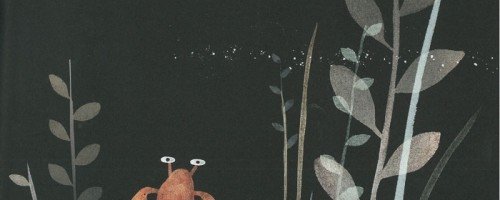
The Best of the Best 2012
I look upon this annual selection process with some trepidation. It’s a kind of literary Sophie’s Choice in the sense that every book I write about is loved, and to choose one above the other seems disloyal and unfriendly. You see, I not only support anthropomorphism in picture books, the books themselves possess qualities far beyond their threaded spines. When words inspire art, and a perfect picture book is born, the characters, be they animal, human or carrot, dance off the page. They have lives. They are alive. And for that I am grateful, and humbled.
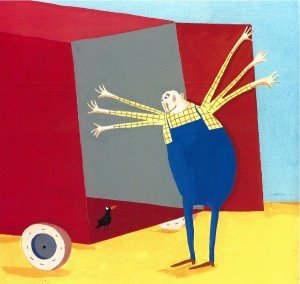 With these words in mind, one book soared like no other this year. Little Bird by Germano Zullo, with illustrations by Albertine is the reason why I collect picture books, and why I write about them. The story of a delivery man in overalls, a sandwich, and a little black bird made my heart go thump this year. It’s that simple. Little Bird is the perfect embodiment of what is best in us: kindness, humour, beauty, and above all, possibility.
With these words in mind, one book soared like no other this year. Little Bird by Germano Zullo, with illustrations by Albertine is the reason why I collect picture books, and why I write about them. The story of a delivery man in overalls, a sandwich, and a little black bird made my heart go thump this year. It’s that simple. Little Bird is the perfect embodiment of what is best in us: kindness, humour, beauty, and above all, possibility.
Named one of the Best Illustrated Books of 2012 by the New York Times, Albertine’s illustrations have a playful simplicity that belie the deeper meaning at the core of Little Bird. Though Albertine and writer Germano Zullo hail from Switzerland, the flat landscapes and prairie colours of blue, 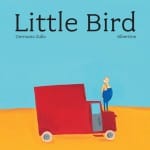 gold and red are reminiscent of western Canada, greatly charming this western Canadian. If not for Brooklyn-based publisher Enchanted Lion Books, Little Bird, originally published in French, may not have seen the light of day in North America. If you love beautiful picture books, start here, and start with Little Bird.
gold and red are reminiscent of western Canada, greatly charming this western Canadian. If not for Brooklyn-based publisher Enchanted Lion Books, Little Bird, originally published in French, may not have seen the light of day in North America. If you love beautiful picture books, start here, and start with Little Bird.
And now, in no particular order, the best of the best this year~

Christmas Books 2012
The snow is piled along the driveway, my breath freezes into cartoon bubbles when I exhale, and I’ve heard Santa Baby-that excruciatingly awful song, about a thousand times on the radio. Must be Christmas, and time for an updated list of festively-oriented books for 2012. Building on an original list compiled in 2010, I am pleased to add a couple of new publications to the scroll of Xmas excellence, and a few from years past. As I said in 2010, anyone who collects illustrated picture books knows that Christmas is when artists come out to play~when the pencils are the pointiest, the colours the juiciest, and storytelling the most luminescent. Perhaps it’s the sparkling snow, or the spirited beverages. Maybe it’s the fruitcake. Whatever the reason, beautiful books abound.
Such as…

This Moose Belongs to Me
This Moose Belongs to Me by Oliver Jeffers is like the shreddie in a bag of Nuts ‘n Bolts: impossible to resist, and so spectacular in flavour it makes the pretzels and cheesy things pale in comparison. I know. Could this metaphor be more strained? I will confess that I’m experiencing difficulty coming up with adjectives for the singular brilliance of artists like Oliver Jeffers, Jon Klassen, Lisbeth Zwerger, and the other illustrators who populate this blog (and elsewhere.) While these artists are few, they are without a doubt masters of their respective mediums, and at the core of what is arguably a highpoint in the history of illustration. A low-point as well, as there are many more bad books than good, and e-readers threaten to erase or at least diminish the sensual and visual pleasure of a truly great picture book. At this moment, however, the privilege still exists, and I would strongly recommend that you get your hands on This Moose Belongs to Me.
